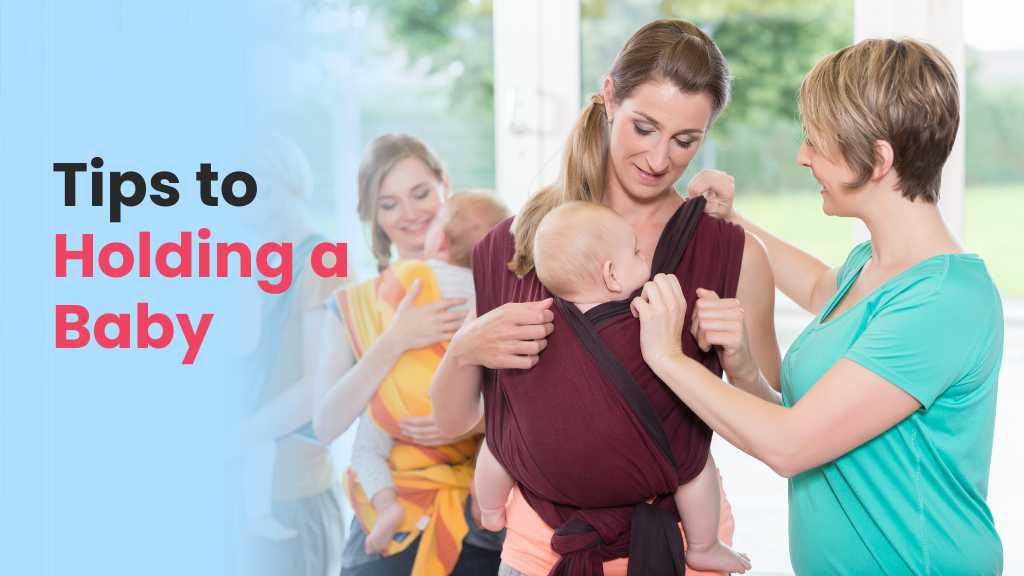
Table of Contents
Welcoming a newborn into the world is a magical and life-changing experience. Along with the joy and excitement, there comes a sense of responsibility. One of the most important aspects of caring for your newborn is knowing how to hold a newborn safely and comfortably. In this comprehensive guide, we will explore the proper techniques and best practices for holding a newborn baby and how not to hold a newborn baby, ensuring their well-being and your peace of mind.
Learn complete guide on How to hold a newborn baby:
The Significance of Safely Holding a Newborn Baby
Handling a newborn baby may seem like second nature to many parents, but it’s a skill that should never be taken lightly. Before we delve into the specifics of how to hold a newborn, it’s crucial to understand why proper handling is of paramount importance.
Newborns are delicate, fragile beings who have just entered the world, and their tiny bodies require extra care and attention. One of the most critical aspects of this care is ensuring that you handle them correctly, especially because their neck muscles are not fully developed at this stage.
Here’s why proper handling is so vital: How to hold a newborn
- Underdeveloped Neck Muscles: Newborns are born with neck muscles that are still in the process of strengthening. This means they cannot support the weight of their own heads effectively. As a result, their heads tend to wobble, and they have limited control over their neck movements.
- Risk of Injury: Failing to provide proper support to a newborn’s head and neck can lead to various risks. The most immediate concern is the potential for injuries. Without adequate support, the baby’s head can flop backward or to the side, potentially causing strain or injury to their neck muscles or spine.
- Discomfort and Stress: Imagine the discomfort and stress you would feel if your head were unsupported and constantly wobbling. The same applies to newborns. Improper handling can lead to discomfort and anxiety, which is not conducive to a happy and content baby.
- Bonding and Trust: Proper handling is not only about safety but also about building trust and bonding with your baby. When you hold your baby securely and comfortably, it fosters a sense of security and well-being, which is crucial for their emotional development.
- Overall Well-Being: Proper newborn handling contributes to the baby’s overall well-being. It can affect their mood, sleep quality, and even their feeding patterns. A comfortable and relaxed baby is more likely to thrive and grow healthily.
Understanding the importance of proper newborn handling sets the stage for a positive and nurturing parent-child relationship. It safeguards the baby’s safety, comfort, and well-being during those precious early months when their bodies are still developing. So, before we delve into the practical aspects of holding a newborn, let’s keep in mind that every gentle touch and secure embrace plays a vital role in shaping their world.
Preparing to Hold Your Newborn
Before you even attempt to hold your newborn, it’s essential to make sure you’re adequately prepared. Here are some key steps to take: How to hold a newborn
- Wash Your Hands: Always start by washing your hands thoroughly with soap and water. Newborns have vulnerable immune systems, and clean hands are crucial to prevent the spread of germs.
- Choose a Comfortable Spot: Find a comfortable, well-supported chair or a cushioned surface where you can sit down. Ensure that your back is well-supported, as you may be holding your baby for an extended period.
How to Hold a Swaddled Baby: How to hold a newborn?
Once you’ve swaddled your baby, the idea of holding them becomes less intimidating. After all, when they resemble a snug burrito, concerns about limbs and movements fade away.
Let’s explore how to hold a swaddled baby.
1. Cradle Hold:
Purpose: The cradle hold is excellent for soothing and bonding with your baby. It allows for gentle rocking motions and eye contact, fostering a sense of security.
Technique: Cradle the baby’s head and neck with one arm, ensuring your fingers support behind their head and your thumb behind one ear. Use your other arm to support their body, with their legs on either side of your body.
Ideal for: This hold is suitable for various activities, such as feeding, cuddling, and comforting your baby.
2. Football Hold (Clutch Hold):
Purpose: The football hold is often chosen for breastfeeding, especially for mothers who have had a C-section or twins. It provides easier access to the breast.
Technique: Hold the baby under your arm, positioning their head near your elbow and their legs extending down your side. Support their body with your arm and use your other hand to assist with breastfeeding.
Ideal for: This hold is primarily used for breastfeeding but can also be helpful for burping.
3. Shoulder Hold:
Purpose: The shoulder hold is an effective way to burp your baby after feeding, helping them release any trapped gas.
Technique: Place the baby on your shoulder with their head resting on your shoulder and their body draped over your back. Pat or rub their back gently to encourage burping.
Ideal for: This hold is specifically used for burping and comforting the baby after a feed.
4. Sling or Baby Wrap Hold:
Purpose: Using a sling or baby wrap allows you to carry your baby close to your body while keeping your hands free for other tasks.
Technique: Different types of slings and wraps have various wrapping techniques, but they generally involve securing the baby close to your chest or hip using the fabric.
Ideal for: This hold is versatile and suitable for everyday activities, from household chores to outdoor adventures.
5. Kangaroo Hold:
Purpose: Kangaroo care or the kangaroo hold promotes skin-to-skin contact and is particularly beneficial for premature or newborn infants.
Technique: Place the baby against your bare chest, with their skin in direct contact with yours. Use a blanket to cover both of you for warmth.
Ideal for: Kangaroo care helps regulate the baby’s body temperature and promotes bonding, especially for preemies.
6. Tummy Time Hold:
Purpose: Tummy time is crucial for a baby’s physical development. It helps strengthen their neck and upper body muscles.
Technique: Place the baby on their stomach on a flat, safe surface, such as a playmat or the floor. Supervise them closely during tummy time.
Ideal for: Tummy time is essential for all infants and helps them build the strength needed for crawling and eventually sitting up.
Remember that the choice of hold may depend on your baby’s age, developmental stage, and individual preferences. Always prioritize safety and comfort while holding your baby, and be attentive to their cues and signals to ensure a positive and nurturing experience.
Common Questions About How to hold a Newborn Baby
Before we conclude this guide on holding a newborn baby, let’s address some common questions you may have holding a newborn baby can be both exciting and nerve-wracking, especially for new parents or caregivers. It’s natural to have questions about how to hold a newborn safely and comfortably. Here are some common questions about holding a newborn baby and their answers:
- How should I support a newborn’s head and neck when holding them?
Always provide full support to a newborn’s head and neck. Cradle their head with one hand, using your fingers to support behind their head and your thumb behind one ear. Use your other arm to support your body.
- Is it okay to hold a newborn in different positions?
Yes, you can hold a newborn in various positions, such as the cradle hold, face-to-chest hold, or even while feeding. The key is to ensure their head and neck are well-supported in any position.
- Can I hold a newborn too much?
No, you cannot hold a newborn too much. In fact, holding your baby is an essential part of bonding and providing comfort during their early months. Babies benefit from skin-to-skin contact and close interaction with caregivers.
- Is there a specific way to hold a newborn while breastfeeding?
The choice of hold while breastfeeding can vary, but many mothers find the cradle hold or football hold effective. The key is to ensure the baby latches on properly and is comfortable.
- How do I know if my baby is comfortable in the hold I’m using?
Watch for signs of comfort, such as a relaxed body, steady breathing, and content expressions. If the baby seems fussy or uncomfortable, try adjusting your hold until they are at ease.
- Are there any holds to avoid with a newborn?
Avoid any holds or positions that place pressure on the baby’s head, neck, or chest. Never shake a baby or engage in sudden, jerky movements, as this can be dangerous.
- How can I safely transfer a newborn from my arms to a crib or bassinet?
To transfer a sleeping or drowsy baby from your arms to a crib or bassinet, make sure the sleep environment is safe and free of hazards. Lower the baby gently onto their back, ensuring they are positioned correctly.
Remember that every baby is unique, and what works best may vary from one baby to another. Always prioritize safety, be attentive to your baby’s cues, and trust your instincts as you navigate the rewarding journey of holding and caring for your newborn.
Concluding Our Discussion on How to Hold a Newborn Baby
Holding a newborn baby is a delicate yet deeply rewarding activity. Always remember to support their fragile head and neck, ensuring their safety and comfort. Through gentle, loving embraces, you not only provide warmth and security but also lay the foundation for a strong parent-child bond. Trust your instincts, be responsive to your baby’s cues, and cherish these precious moments of closeness. Holding your newborn with care and attention is a beautiful expression of love that will benefit both you and your little one throughout your journey of parenthood.










